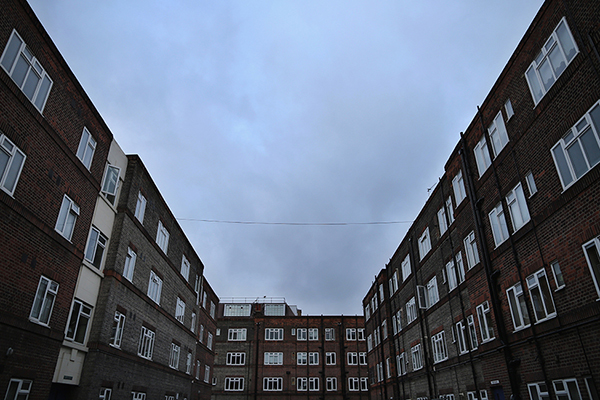You are viewing 1 of your 1 free articles
New Era: one year on
A year ago, the new landlord of a Hackney estate ripped up the rental rulebook. Sophie Barnes returns to Hoxton to find out how the personalised rents model has bedded in
Video:
new features style

Source: Getty
Three years ago, the New Era Estate became the poster child for London’s housing crisis. In March 2014, private equity firm Westbrook bought New Era’s 93 homes from Robert Lever, a member of the family who first built the estate in the 1930s, and announced its intention to increase rents by 10%, pushing out families who were born and raised within its weathered brick walls.
The story had all the ingredients of a media storm: gentrification, the instability of the private rented sector, and a dollop of star power in the form of Russell Brand. Reporters flocked to Hoxton to cover it.
Video:
Ad slot
At the height of the 2014 resident-led protests, affordable housing provider Dolphin Living bought the estate and announced it would introduce personalised rent whereby households would pay according to their income. The policy went live last April.
Almost one year on, Inside Housing visits the estate to find out how both tenants and landlord have adapted to the innovative new model.
Bespoke culture
Unusually, New Era is home to a number of large family groups. This situation came about because the on-site caretaker managed the lettings process and never advertised vacant flats to the general public, according to Mark Kent, managing director at Dolphin Living. Instead, new lettings were advertised through word of mouth. This meant children who grew up on the estate often moved into neighbouring homes when they became adults. These families were often on low incomes, but New Era remained affordable as the landlord held rents at around 50% of market rates. If evicted now, many families would struggle to afford other accommodation in Hackney, where rents are among the highest in London.
In return for cheaper rents, residents were responsible for repairs. Many have installed their own kitchens and bathrooms and had taken out loans to pay for them, some of which they are still paying off today.
Mr Kent describes New Era as “an estate that time forgot… People were paying rent in envelopes through the post box of the caretaker’s office”.

Source: Rex Features
Comedian Russell Brand with Danielle Molinari (right), New Era resident and one of the leading campaigners against the rent hikes back in 2014
Given the existing arrangement, there was local outcry when Westbrook announced its intention to increase the rent by 10%. Tenants said they could not afford such a steep increase and feared they would face eviction within months. Residents appealed to Russell Brand (who lived locally) for support and suddenly it was a major news story.
Following a march on Downing Street, then-mayor of London Boris Johnson and mayor of Hackney Jules Pipe put pressure on Westbrook to sell to Dolphin Living.
For Dolphin Living, which operates mostly in the narrow geography of inner London, this was a nerve-wracking undertaking. “We promised that no one would have to leave the estate which was a scary prospect for us,” remembers Mr Kent. “It’s quite a commitment to make.”
New rent model
Dolphin Living knew charging rent at 50% of the market rate was unsustainable. It came up with the solution of slowly increasing rent based on individual households’ incomes.
“We said: ‘If you tell us how much you earn, we will find a way to agree what reasonable outgoings are for you and we will see what is left over for rent.’ We could not reduce the rents because then it starts to fall apart in terms of viability, but we said we wouldn’t increase the rent by any more than the Consumer Price Index [CPI] plus 1% if you’re in a situation when your current rent is more than you can afford or you’re claiming housing benefit,” Mr Kent explains.
Read more about the New Era Estate
A new era for affordable rents? Why the New Era Estate is a test bed for a new type of fair rent that challenges the definitions of affordability
The landlord struggled to agree how much living cost a household should be able to keep because, as Mr Kent puts it, that figure is a “really subjective matter, depending on what people think they should be able to do with their lives”.
“Our whole purpose for existing is to help the working Londoner.”
Mark Kent, Dolphin Living
In the end, Dolphin chose to use the Joseph Rowntree Foundation’s Minimum Income Standard. Because of the range of household circumstances on the estate, the landlord ended up with a huge range of rent variations based on whether or not a household had children, how old they were, the hours of work and myriad other factors.
There were still a number of problems to be ironed out. For example, tenants whose salary goes up or those without a regular monthly income.
Solutions were agreed, but another spanner in the works was raised by the New Era tenants’ committee when Dolphin approached it for feedback: the new policy could see some rents increase drastically overnight for those higher-earning tenants.
Eventually the tenants’ committee convinced the landlord that expecting a resident to adjust their household budget overnight to cope with a large rent increase would not be fair. Dolphin agreed to put a cap on rent increases at CPI plus 4.5% “so those people who can afford to pay an awful lot more rent will pay more each year until they hit their personalised rent”, Mr Kent says.
When Inside Housing visits the New Era Estate nine months later, Danielle Molinari, one of the leading campaigners against the rent hikes back in 2014, is balancing shopping bags as she searches in her bag for her keys. She says the new rent structure has worked well for the estate.
“We have monthly tenant meetings and Dolphin come along every three months. They are always approachable. Pretty much everyone has gone for the new rent levels.”

Source: Jonathan Goldberg
Mark Kent, managing director at Dolphin Living, who has overseen a groundbreaking rental model
Considering how things could have turned out, Ms Molinari is happy with her lot. “I think it is a fair rent. Dolphin are very understanding with the way they have worked out the levels.”
For Dolphin, its raison d’être is perfectly reflected in the New Era Estate. “Our whole purpose for existing is to help the working Londoner, the people that perhaps just lose out on the major support from the benefits system, or are not eligible for council waiting lists for social housing, but are priced out of the city,” explains Mr Kent.
But it is not all about philanthropy for Dolphin. Mr Kent points out that the personalised rent policy “made sense in terms of our business model”. Already Dolphin Living has collected 11% more in rental income from New Era than under the old landlord. The average rent under the old model was £172 per week, whereas under personalised rents it is £187 among the original community, rising to £197 when new tenants are factored in.
“Pretty much everyone has gone for the new rent levels.”
Danielle Molinari, New Era tenant
Questioned over whether Dolphin’s decision to step in as New Era’s white knight was a good bit of public relations, Mr Kent insists it was actually a “great publicity risk”.
“There is a risk because we buy these estates recognising there is a reason the rents were trying to be increased by the previous landlords or they were trying to evict people and sell the homes. As it stands, it’s not a sustainable arrangement.”
The flats are roughly of the same standard, so residents who pay more in rent do not necessarily receive a higher-quality property. Properties that fall empty are refurbished so new tenants could have better conditions than existing tenants. The model is based on the homes being the same specification, so what you pay for is not always what you get.
The bespoke model seems to have worked well at New Era but could it work on a wider scale? Sadiq Khan’s London Living Rent homes will have rents linked to average incomes in an area, a move that would have been inconceivable a few years ago, but these are not personalised rents.
John Bibby, senior policy officer at Shelter, says the general principle of basing rents on a household’s “ability to pay” rather than a “discount on market levels” is an approach Shelter “wholeheartedly endorses”. However, Dolphin Living’s scheme can only be a “small part of the solution” to make housing more affordable, he adds, “because they can only be run by organisations with a charitable mindset and low debt liability”.
Melanie Rees, head of policy at the Chartered Institute of Housing, notes it would be difficult to scale up the bespoke rent approach because of the amount of work involved in verifying incomes “particularly as they can fluctuate for people on flexible employment contracts”.
Landlords also need to be sure that the rents set are enough to cover their management and maintenance costs, she adds. The model of basing rents on income seems to be gaining traction, in London at least. As lower earners are increasingly priced out of the capital, New Era could either be a new model for the city or just an interesting anomaly.








